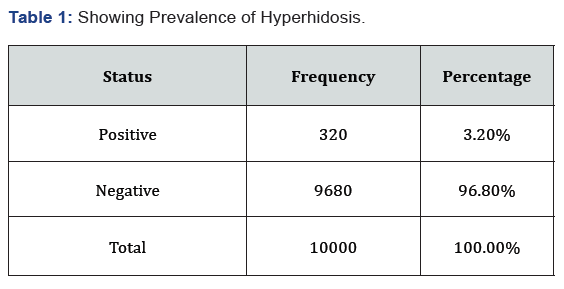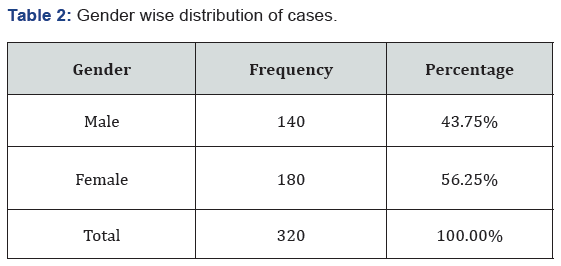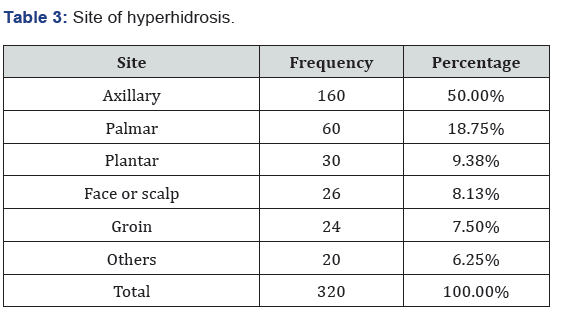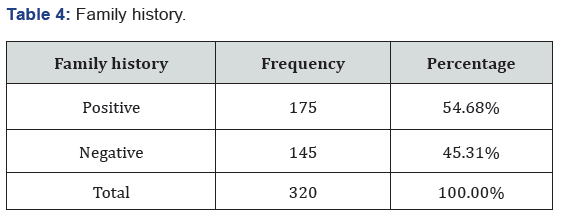Hyperhidrosis and its Prevalence in a Population: A Cross Sectional Survey- Juniper Publishers
Juniper Publishers- Open Access Journal of Annals of Reviews & Research
Hyperhidrosis and its Prevalence in a Population: A Cross Sectional Survey
Abstract
Background
Hyperhidrosis is a quite common condition. There is a wide variation in the reported prevalence of hyperhidrosis in the available literature.
Objectives
This study aims to examine the prevalence of hyperhidrosis [1].
Methods
A cross sectional survey of a population was carried out. The subjects were classified to have hyperhidrosis using the criteria of International Hyperhidrosis Society. The prevalence of HH was calculated for the entire study population.
Results
The prevalence of hyperhidrosis was 3.2% (320 cases) in the study population of 10000.
Conclusion
Hyperhidrosis affects a much larger population than previously reported.
Keywords: Prevalence, Hyperhidrosis, Population; Cross-sectional study
Introduction
Hyperhidrosis (HH) is a condition characterized by excessive sweating without the usual triggers such as mental, physiological or thermal stimuli. There are two broad categories of hyperhidrosis, secondary and primary. Secondary hyperhidrosis occurs with an underlying medical condition, such as chronic infections and other catabolic conditions [1]. In contrast, primary hyperhidrosis (primary HH) occurs in a symmetrical fashion with an age of onset less than 30 years and without underlying medical conditions. While the significant negative impact of primary HH is well known, especially in developed countries [2] there have been large variations in the prevalence of primary HH in various reports, ranging from 2.8% in the United States [3], to 16.3% in Germany [4] and 12.8% in Japan [5], the reasons for the discrepancies are not known. However, the demographical and geographical aspects of various studies differ from one study to the next. Further, the criteria used for the diagnosis and classification of HH also varied from study to study.
Methods
It was a cross sectional survey carried out in a rural community in Srinagar in April 2014. The subjects were classified to have hyperhidrosis using the criteria of International Hyperhidrosis Society. The prevalence of HH was calculated for the entire study population. The questionnaire contained the following components: age, sex, reasons for presenting for dermatological assessment, symptoms related to day-time.
Statistical Analysis
The data analysis was performed with Microsoft Excel and SPSS 20. The prevalence of HH was measured for the whole population.
Discussion
Hyperhidrosis (HH) is a condition characterized by excessive sweating without the usual triggers such as mental, physiological or thermal stimuli. There are two broad categories of hyperhidrosis, secondary and primary. Much of the current knowledge is directed on treatment while only a few studies are focused on determining the prevalence. In our study the prevalence of hyperhidrosis was 3.2%. The prevalence of primary hyperhidrosis has been the subject of examination by several groups focusing on populations that differ in ethnic compositions, geographical locations, age, and gender. However, the findings vary from one study to the other: 2.8% in the United States [3], 4.4% PPH in Fuzhou, China [6], 16.3% in Germany [4] and 12.8% in Japan [5]. Possible reasons for the wide variation may include differences in study methods, precise definitions used, ethnic composition of the study subjects, age, gender and the environment. Females were the dominant sex affected in our study and also axillary hyperhidrosis was the commonest site affected. Also, majority of the patients had positive history of hyperhidrosis. Further studies are needed to understand the distribution, and effect of hyperhidrosis in this part of world and to identify the aggravating factors (Tables 1-4).




To know more about Juniper Publishers please click on: https://juniperpublishers.com/aboutus.php
For more articles in Open
Access Journal of Reviews & Research please click on:
https://juniperpublishers.com/arr/index.php
To know more about Open Access Journals please click on: https://juniperpublishers.com/journals.php


Comments
Post a Comment